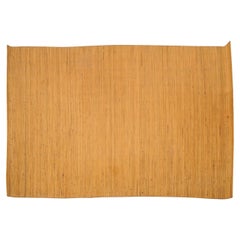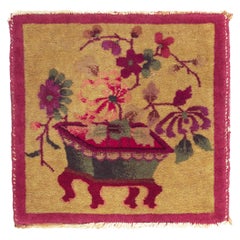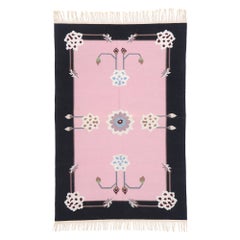Reed Chinese and East Asian Rugs
to
Width
to
Length
to
1
1
796
5,481
5,135
540
437
1
1
1
1
1
1
1
Material: Reed
Vintage Borneo Long-House Bamboo Reed Floor Mat
Located in Atlanta, GA
A Malaysian hand-crafted bamboo reed floor mat. This vintage bamboo mat would have originally graced the floors in a Dayak long-house in Borneo; an artisan ...
Category
20th Century Malaysian Reed Chinese and East Asian Rugs
Materials
Bamboo, Reed
Related Items
Antique Tibetan Meditation Mat, Chinese Art Deco Rug
Located in Dallas, TX
78436 Antique Chinese Art Deco Rug, 01.05 x 01.06.
Emanating timeless beauty with incredible detail and texture, this hand knotted wool antique Chinese Art Deco rug is a captivating vision of woven beauty. The floral design and symbolic colorway woven into this piece work together creating a truly unique look. This small Chinese Art Deco rug...
Category
Early 20th Century Chinese Tibetan Reed Chinese and East Asian Rugs
Materials
Wool
Vintage Chinese Floral Kilim Rug
Located in Dallas, TX
77814 vintage Chinese Floral Kilim rug 04'02 x 06'03. This hand-woven wool vintage Chinese kilim rug features a color blocked field and border festoon...
Category
Late 20th Century Chinese Chinese Export Reed Chinese and East Asian Rugs
Materials
Wool
Early 20th Century Handmade Chinese Peking Long Gallery Carpet in Cream & Blue
Located in New York, NY
An antique Chinese Peking long gallery carpet handmade during the early 20th century in shades of cream and blue.
Measures: 5' 9" x 16' 3"
The craft of the hand-knotted carpet in China, and the surrounding areas including Mongolia and Tibet, extends into the early centuries of the first millennium, C.E., but we really have a firm grasp only beginning in the later 16th century with large, very coarsely woven carpets, often depicting dragons, created for the Imperial Forbidden City palaces. Chinese carpets have always been commercial and there are no tribal groups responsible for any of the carpet weaving strains.
When the Ming Dynasty fell in 1644, with no Imperial patrons, production moved to the city of Ningxia in north central China where several workshops turned out more finely woven pieces for the Mandarins of the administrative Ch’ing bureaucracy and well-to-do merchants. Ningxia was the major Chinese carpet center up through most of the 19th century, with first allover and then medallion designs on cotton foundations in medium weaves. Palettes were initially limited to yellows, dark blue and cream, but later widened to include reds, browns and even green. These antiques were the first Chinese carpets to be exported to the West and they fitted in well with the craze for Chinese blue-and-white porcelain in the second half of the 19th century. Ningxia also wove shaped and rectangular small rugs for saddle underlays, chair (“throne”) seats and shaped backs, pillar carpets with dragons or monks for Buddhist monasteries, and long divided runners for monastery meditation halls. These small rugs are among the most collectible of all Chinese weavings.
Weavers from Ningxia set up workshops in the capital Peking (Beijing) in the 1860’s and began weaving Western room sizes for export, primarily to America. In blue – and – white and polychrome palettes, with round wreath medallions, precious objects, seasonal flowers, paeonies, lotuses, fretwork, clouds, butterflies and bats, all relatively spaciously drawn. The round “Shou” (Good Luck) character is also a prominent decorative motif. There are also a few Peking landscape pictorials with pagodas, houses, bridges, waterscapes and boats. Peking carpets were woven right up until WWII and production began again after the Cultural Revolution around 1970. They are moderately well-woven, on cotton foundations, exactingly executed and indisputably Chinese. Many are in the blue-and-white style. Nothing else looks like a Peking carpet and for a Chinese “look” in a room, they are absolutely indispensable. Sizes range from scatters and a few runners, through the popular 9’12’ size, to large carpets over 20’ which must have been special orders. The earliest Peking Revival carpets are pliable and fairly thin, but they became heavier and more compact in the 20th century, in competition with Art Deco carpets from Tientsin. The modern, post- 1970, pieces are in the traditional Peking style, but are a little too regular and neat. Exactitude has been favored over character, as hard to explain that as it is.
There are a number of all-silk and silk-and –metal thread pieces, many with inscriptions purporting to link them with rooms in the Imperial palaces, bringing very substantial auction prices, but none are really antique. The genre emerged after WWI and the present demand comes from mainland Chinese. The silk piles often stand in pattern relief against flat woven gold metal thread grounds. The inscriptions are apocryphal, the rugs are flashily opulent, perfect for nouveaux riches.
The Art Deco period between the two World Wars saw a distinctive carpet industry developing in Tientsin (Tianjin) in northeastern China. These are highly prized for their transitional design character, neither overtly Chinese, nor abstractly modern/contemporary. Woven exclusively for export, usually by and for American firms, such as Nichols and Elbrook, they are totally in the “Jazz Age Modern” style of the 1920’s, often without borders, with abstract or abstracted patterns, and only with, at best, a few Chinese-y pattern elements. Vases asymmetrically placed in the corners are features of some of the more Chinese-y carpets. Open fields with floral sprays and branches growing in from the edges are anther design innovation. Often, Chinese motives have been re-imagined in more sharp-edged, abstract manners. Some have no references whatsoever to natural elements. The patterns are sharp and the rugs are never subdued, soft or restrained. The rugs are heavily constructed, with crisp, unfading dyes and medium to medium coarse weaves on cotton foundations. All are extremely well-executed, with none of the vagaries, variations or twists found on even high-quality Persian rugs. The majority are in the 9’ by 12’ format and a surprising number can be found in top condition. There also was a substantial production in Peking from, especially from the Fette factory. Elliptical and round carpets, and lighter, often pastel colors, were a specialty. Nothing looks like an Art Deco Chinese and they work well with traditional Chinese furniture and the most modern decor as well. These is no substitute for a good Chinese Art Deco carpet.
Chinese carpets also include small scatters from Tibet, with high quality wool, floating dragons and allover textile patterns. The colors of vintage and modern pieces are bright, but there are antique small rugs...
Category
Early 20th Century Chinese Art Deco Reed Chinese and East Asian Rugs
Materials
Wool
$6,875
W 69 in L 195 in
Vintage Chinese Art Deco Rug Art Nouveau Rug Khotan Rug Pink
Located in New York, NY
Rare Vintage Chinese Art Deco Art Nouveau Khotan Rug Geometric
Pink
8'7" x 11'10" (9 x 12)
262cm x 361cm
Circa 1965
"This an exquisite Rare vintage Hand made Chines...
Category
1960s Chinese Vintage Reed Chinese and East Asian Rugs
Materials
Wool
Dayak Tribe Mat with Spiral, Animal and Human Tribal Motifs, Borneo, Indonesia
Located in Jimbaran, Bali
This floor mat once occupied a tribal long house of the Dayak Tribe of Borneo. It is made from woven dyed and natural coloured rattan fibres & features a stunning array of tribal spi...
Category
Late 20th Century Indonesian Tribal Reed Chinese and East Asian Rugs
Materials
Rattan
$800
W 40.16 in L 84.65 in
Vintage Bamboo Mat
Located in New York, NY
Hand made vintage bamboo mat from Borneo in natural and espresso colors. An unusual long size and unique two toned.
Andrianna Shamaris. The Leader In Modern Organic Design.
Category
20th Century Primitive Reed Chinese and East Asian Rugs
Materials
Bamboo
Vintage Chinese Tabriz Rug with Traditional Style
Located in Dallas, TX
79242 Vintage Navy Blue Chinese Tabriz Rug, 04'01 x 05'09. This hand-knotted wool vintage Chinese Tabriz rug is a rare treasure of refined elegance, a woven masterpiece that speaks t...
Category
Late 20th Century Chinese Tabriz Reed Chinese and East Asian Rugs
Materials
Wool
Vintage Chinese Art Deco Rug
Located in Saint Ouen, FR
Beautiful Chinese Art Deco rug with nice design and white field color, entirely hand knotted with wool velvet on cotton foundation.
Category
Mid-20th Century Chinese Art Deco Reed Chinese and East Asian Rugs
Materials
Wool
Vintage Simple Design Tibetan Rug
Located in Saint Ouen, FR
Beautiful light colors Tibetan Nepal rug, circa 1980 with a simple design and beautiful yellow field, blue and pink, entirely hand knotted with wool velv...
Category
Late 20th Century Tibetan Art Deco Reed Chinese and East Asian Rugs
Materials
Wool
Vintage Chinese Khotan Style Rug
Located in New York, NY
A vintage Chinese carpet with a Khotan design from the second quarter of the 20th century.
Measures: 9' 0" x 11' 8"
Category
Mid-20th Century Chinese Khotan Reed Chinese and East Asian Rugs
Materials
Wool
Dayak Tribe Mat with Buffalo Motif, Kalimantan, Indonesia
Located in Jimbaran, Bali
This floor mat once occupied a tribal long house of the Dayak Tribe of Borneo. It is made from woven dyed and natural coloured rattan fibres & features tri...
Category
Late 20th Century Indonesian Tribal Reed Chinese and East Asian Rugs
Materials
Rattan
Vintage Contemporary Michaelian & Kohlberg Tibetan Rug
Located in Dallas, TX
78160 vintage Michaelian & Kohlberg Tibetan rug 08'09 x 09'04. With effortless beauty and a strong sense of dimensionality, this hand-knotted wool M&K Tibetan rug is engaging, yet we...
Category
Late 20th Century Nepalese Tribal Reed Chinese and East Asian Rugs
Materials
Wool


